Water Allocation Computation Model for River and Multi-Reservoir System with Sustainability-Efficiency-Equity Criteria
Abstract
:1. Introduction
2. Modeling Concept
2.1. Equalization of Water Allocation Portion
2.2. River System Categories
2.3. Network-Flow Node
2.4. Optimization-Simulation
- Water AvailabilityThe total available water (QA) is described as local inflow (QL) and spill flow/contribution from upstream node (QSi−1) is then:QL depends on hydrologic factors from the inter node catchment area.
- Ecosystem QuotaSustainability of irrigation operations leads to food security and ecosystem sustainability has an impact on environmental stability. Both are important, so they must be integrated [6]. Spill flow in each node must meet the ecosystem water need for sustainable environment [7,34] or QSi ≥ QEi criteria. The environmental water requirements of rivers in Iran are 10% (October–March) and 30% (April–September) of water availability [6], while MEQAA is in line with regulations in Indonesia [35] as:
- EfficiencyThe efficiency criterion is a release (QRi) which is not exceeding demand (QDi) or 0 ≤ QRi ≤ QDi [36]. If the elements 0 ≤ QRi ≤ QDi are divided by QDi, then 0 ≤ Ki ≤ 100% or release portion is:Equation (5) is identical to QR = K. QD meanwhile QR ≤ (QA − QS). K will be classified according to Table 1 for operational information in the irrigation area. Criterion of utility of water available reviewed in the most downstream node. If K < 100% then QS ≈ QE, and if K = 100% then QS ≥ QE.
- Reservoir Operation
- Reservoir operation rule is derived from mass balance in Equation (1) [10,22,37], which for each node is:with Vcal = calculation volume, Vbeg and Vend denote the storage volume at the beginning and end, Vin = inflow, Vloss = losses, Vrel = release, Vspill = spill flow, and Veff = effective capacity. Outflow in Equation (6) is based on boundary 0 ≤ Vend ≤ Veff; that is, if 0 ≤ Vcal ≤ Veff (normal), then Vend = Vcal, and if Vcal > Veff (spill out), then Vend = Veff.
- Based on Equation (6), future periods of operation need to anticipate volumes (Vstock) which is based on the reservoir rule curve. Storage portion (C-factor) in Equation (7) is an indicator of Vend achievement of Vstock. Vstock is the Vend which is expected to be achieved from the current operation. If water is limited, then 0 ≤ Ci < 100% (Vend ≤ Vstock) and if it is at a surplus, then Ci ≥ 100% (Vend ≥ Vstock).
- Rule curve operation is assumed to be cyclical to a certain pattern [38]. The rule curve pattern corresponds to a non-linear function that can be constructed through optimization-simulation based on time series data [34]. This curve can be produced by using the regression method [39]. Rule curve can be transformed into a rule curve coefficient (CRC), such as a sinusoidal curve to facilitate the calculation of the mandatory Vstock period (t + 1). In this MEQAA experiment with single data, the boundary CRC is derived from 0 ≤ Vend ≤ Veff which is divided by Veff so that the stock portion becomes 0 ≤ CRC ≤ 100%, or:Where CRC is analog with K+1. If Vstock > Vbeg, then the volume anticipation will increase, or vice versa.
- Quoted from reservoir operation study in Pandanduri earth-filled dam in Lombok river basin, water loss coefficient from evaporation and seepage 0.7–1% towards Vbeg was obtained [38]. In this MEQAA experiment, total water loss (Vloss) was estimated with 0.7% coefficient, as:For another reservoir, the value of loss coefficient in Equation (9) can be re-adjusted depending on evaporation, storage, and dam construction.
- Volumetric Equally
- To be quantitative, the equity is analogous to the equality of water allocation portion. The K-factor criterion equals inter-users in upstream (i) and downstream (i + 1) [36], that is:
- C-factor criteria that equal inter-reservoir is:
- Practically, Equations (5) and (7) are analogs of the supply/demand ratio. For the portion of the current QR release (K-factor) equals to the portion of anticipation volume Vstock for the coming period (C-factor), then both are equalized with this criterion: (a) if it is surplus then K = 100% (priority for storage or C ≥ K); (b) if it is limited then Kmin ≤ K < 100% (priority for user equal with storage or K ≈ C); and (c) if it is very limited then K < Kmin (priority for user or K > C).In Equation (10) the value of K is obtained from Equation (5).
- In a river system with a suppletion channel/double estuary, the equalization will still review the K-factor and C-factor at each corresponding river reach. The water distribution in this system is controlled by the suppletion regulator towards the target which will be assisted.
- Water Loss at ReachIn the reach of inter-node, there can be a return flow (RF) from the irrigation area that may return to the original/other rivers and lateral loss (LL) due to evaporation/infiltration. Both are difficult to quantify, and LL is estimated by weighting factor per meter of reach length [10]. In MEQAA, RF and LL are assumed to cancel each other (zero).
- Intake CapacityIntake capacity of each node (QC) is assumed to be able to drain QR ≤ QD maximum or QC ≥ QDmax.
2.5. Tracking of River Scheme for Network Equation
2.6. The Criterion of Verification and Validation for the Model
- The syntax code of verification criteria are: (a) configuration of network-flow nodes mapped in domino effect in every river reach; (b) NE structure according to dynamic system and accommodate constraints criteria; and (c) the iteration simulation being able to run to reach the termination status of K-factor, C-factor, and the flow contribution in the suppletion regulator.
- The criteria of output validation are: (a) maximum QR total; (b) the downstream node having a minimum QS value which is its QE value; (c) K-factor, K-factor and C-factor, and C-factor as the portion indicator must reach the maximum-equal value; (d) decision variable is nonnegative (noneg); and e) water balance (WB) control is null.
3. Experimental
3.1. Operation Procedure
3.2. Data Input
4. Results and Discussion
4.1. Network Equation Table
4.2. Output with Equalization
4.3. Output without Equalization
4.4. Output Comparison
5. Conclusions
- MEQAA can track network-flow node configuration in independent river systems to create a network equation structure as the main equation of computational model, with input single data and output based on operation rule and the sustainability-efficiency-equity criteria.
- Number of iterations in the simulation of water allocation depends on the iteration step, network-flow node configuration, local inflow, water demand, and the beginning volume of the reservoir.
- Based on experiments using complex synthetic river schemes and containing many diversions and multi-reservoirs, suppletion channels and double estuaries that are described from the complexity of the system in Lombok river basin, MEQAA as a dynamic system-based deterministic model can work according to its function and the result is in accordance with the constraint.
- The output of MEQAA satisfied the sustainability-efficiency-equity criteria, being that spill flow/contribution flow is adequate with ecosystem quota on downstream nodes; the release is efficient since it does not exceed demand with the K-factor minimum of 40%, and water allocation portion in internode is equal.
- The practice of water allocation by equalization method according to the sustainability-efficiency-equity criteria will simultaneously integrate inter-user benefit and ecosystem quota, release, demand and water availability, upstream-downstream, and wet-dry river, storage portion in multi-reservoirs for current and future periods. In contrast, the first-come-first-serve method will cause a conflict, because of unsustainability-inefficiency-inequity.
Author Contributions
Funding
Acknowledgments
Conflicts of Interest
References
- Fulazzaky, M.A. Review—Challenges of integrated water resources management in Indonesia. Water 2014, 6, 2000–2020. [Google Scholar] [CrossRef]
- Strauß, S. Water conflicts among different user groups in South Bali, Indonesia. Hum. Ecol. 2011, 39, 69–79. [Google Scholar] [CrossRef]
- Eriyatno. Ilmu Sistem-Meningkatkan Mutu dan Efektivitas Manajemen; Guna Widya: Surabaya, Indonesia, 2012. [Google Scholar]
- Roozbahani, R.; Abbasi, B.; Schreider, S.; Ardakani, A. A multi-objective approach for transboundary river water allocation. Water Resour. Manag. 2014, 28, 5447–5463. [Google Scholar] [CrossRef]
- Peraturan Pemerintah Republik Indonesia No. 121 Tahun 2015 tentang Pengusahaan Sumber Daya Air. Available online: http://ditjenpp.kemenkumham.go.id/arsip/ln/2015/pp121-2015bt.pdf (accessed on 18 July 2018).
- UN Water. The United Nations World Water Development Report 2015 “Water for a Sustainable World”; UNESCO: Paris, France, 2015. [Google Scholar]
- Roozbahani, R.; Abbasi, B.; Schreider, S. Optimal allocation of water to competing stakeholders in a shared watershed. Ann. Oper. Res. 2015, 229, 657–676. [Google Scholar] [CrossRef]
- Perera, B.J.C.; James, B.; Kularathna, M.D.U. Computer software tool REALM for sustainable water allocation and management. J. Environ. Manag. 2005, 77, 291–300. [Google Scholar] [CrossRef] [PubMed]
- Sulis, A.; Sechi, G.M. Comparison of generic simulation models for water resource systems. Environ. Model. Softw. 2013, 40, 214–225. [Google Scholar] [CrossRef]
- Wurbs, R.A. Comparative Evaluation of Generalized Reservoir/River System Models—Technical Report No. 282; Texas Water Resources Institute the Texas A&M University System: College Station, TX, USA, 2005. [Google Scholar]
- Hatmoko, W.; Triweko, W.; Yudianto, D. Sistem pendukung keputusan untuk perencanaan alokasi air secara partisipatoris pada suatu wilayah sungai. Jurnal Teknik Hidraulik Puslitbang Sumber Daya Air-Departemen Pekerjaan Umum Republik Indonesia 2012, 3, 71–86. [Google Scholar]
- Farriansyah, A.M.; Juwono, P.T.; Suhartanto, E.; Dermawan, V.; Alyaminy, R.S.Z. The Performance of Equalization Model of Water Allocation Inter Irrigation Areas in River System. In Proceedings of the Third International Conference on Sustainable Infrastructure and Built Environment, ITB, Bandung, Indonesia, 26–27 September 2017. [Google Scholar]
- Farriansyah, A.M.; Corsel, A.R.; Novelia, G.R. Rekayasa model alokasi air tahunan Wilayah Sungai Lombok (Studi DAS Jangkok). In Proceedings of the 31st Indonesian Association of Hydraulic Engineers Annual Conference (PIT HATHI), Padang, Indonesia, 22–24 August 2014. [Google Scholar]
- Farriansyah, A.M.; Novelia, G.R.; Husnan, B. Alokasi air real time (kasus: Sungai Jangkok). In Proceedings of the 32ndIndonesian Association of Hydraulic Engineers Annual Conference (PIT HATHI), Malang, Indonesia, 6–8 November 2015. [Google Scholar]
- Mensik, P.; Stary, M.; Marton, D. Water Management Software for Controlling the Water Supply Function of Many Reservoirs in a Watershed. Water Resour. 2015, 42, 133–145. [Google Scholar] [CrossRef]
- Kim, T.J.; Wurbs, R.A. Modeling river/reservoir system management with the expanded WRAP. KSCE J. Civ. Eng. 2011, 15, 1457–1467. [Google Scholar] [CrossRef]
- Li, H.; Shao, D.; Xu, B.; Chen, S.; Gu, W.; Tan, X. Failure Analysis of a New Irrigation Water Allocation Mode Based on Copula Approaches in the Zhanghe Irrigation District, China. Water 2016, 8, 251. [Google Scholar] [CrossRef]
- Farriansyah, A.M.; Aribowo, G.G. Adaptasi alokasi air akibat indikasi perubahan iklim dan kompleksitas sistem sumber daya air di Wilayah Sungai Pulau Lombok. In Proceedings of the 26thIndonesian Association of Hydraulic Engineers Annual Conference (PIT HATHI), Banjarmasin, Indonesia, 23–25 October 2009. [Google Scholar]
- Kartabrata, M.; Marjanto, W.D. Penggunaan computer model untuk distribusi air dan alokasi air pada Water Operation Centre (WOC) Unit—Dinas Pekerjaan Umum Provinsi Nusa Tenggara Barat (NTB). Jurnal Informasi Teknik, Direktorat Jenderal Pengairan-Departemen Pekerjaan Umum Republik Indonesia 1994, 14, 46–60. [Google Scholar]
- Hatmoko, W. Indeks kelangkaan air irigasi. In Proceedings of the Paper Conference of Indonesia’s INACID, Palembang, Indonesia, 16–18 May 2014; Volume 1. [Google Scholar]
- Rencana Alokasi Air Tahunan 2016/2017 dan Rencana Alokasi Air Tahunan 2017/2018 Wilayah Sungai Lombok; Balai Wilayah Sungai Nusa Tenggara I (BWS-NT I): Mataram, Lombok, Indonesia, 2016/2017.
- Yazdeli, Y.B.; Haddad, O.B.; Mehdipour, E.F.; Mariño, M.A. Evaluation of real time operation rules in reservoir systems operation. Water Resour. Manag. 2014, 28, 715–729. [Google Scholar] [CrossRef]
- Singh, A. Review: Computer-based models for managing the water-resource problems of irrigated agriculture. Hydrogeol. J. 2015, 23, 1217–1227. [Google Scholar] [CrossRef]
- Guo, S.; Chen, J.; Li, Y.; Liu, P.; Li, T. Joint operation of the multi-reservoir system of the Three Gorges and the Qingjiang cascade reservoirs. J. Energies 2011, 4, 1036–1050. [Google Scholar] [CrossRef]
- Haro, D.; Paredes, J.; Solera, A.; Andreu, J. A model for solving the optimal water allocation problem in river basins with network flow programming when introducing non-linearities. Water Resour. Manag. 2012, 26, 4059–4071. [Google Scholar] [CrossRef]
- Koch, H.; Grunewald, U. A comparison of modelling systems for the development and revison of water resources management plans. Water Resour. Manag. 2008, 23, 1403–1422. [Google Scholar] [CrossRef]
- Wegerich, K. A critical review of the concept of equity to support water allocation at various scales in the Amu Darya Basin. Irrig. Drain. Syst. 2007, 21, 185–195. [Google Scholar] [CrossRef]
- Gorantiwar, S.D.; Smout, I.K. Performance Assessment of Irrigation Water Management of Heterogeneous Irrigation Schemes: 1. A Framework for Evaluation. Irrigation and Drainage Systems; Loughborough University’s Institutional Repository: Leicestershire, UK, 2005. [Google Scholar]
- Kundzewicz, Z.W.; Kindler, J. Multiple criteria for evaluation of reliability aspects of water resource systems. In Proceedings of the Modelling and Management of Sustainable Basin-scale Water Resource Systems (Proceedings of a Boulder Symposium), Boulder, CO, USA, 1–6 July 1995; IAHS Publ, No. 231. pp. 217–224. [Google Scholar]
- Kelley, T.; Johnson, S.H., III. Technical Communication: Use of Factor-K Water Allocation System in Irrigation Management: Theory and Application in Indonesia. Water Resour. Manag. 1989, 3, 49–71. [Google Scholar] [CrossRef]
- Peraturan Menteri Pekerjaan Umum dan Perumahan Rakyat Republik Indonesia No.12/PRT/M/2015 tentang Eksploitasi dan Pemeliharaan Jaringan Irigasi. Available online: http://birohukum.pu.go.id/uploads/DPU/2015/PermenPUPR12-2015.pdf (accessed on 18 July 2018).
- Dutta, D.; Kima, S.; Vazea, J.; Hughesa, J.; Yanga, A. Water accounting for sustainable water resources management—Role of hydrological modelling. In Proceedings of the 21st International Congress on Modelling and Simulation, Canberra, Australia, 29 November–4 December 2015; A CSIRO Land and Water. pp. 2040–2046. [Google Scholar]
- Gonzalez, J.F.; Decker, C.A.; Hall, J.W. A linear programming approach to water allocation during a drought. Water 2018, 10, 363. [Google Scholar] [CrossRef]
- Meijer, K.S.; Krogt van der, W.N.M.; Beek van, E. A new approach to incorporating environmental flow requirements in water allocation modeling. Water Resour. Manag. 2012, 26, 1271–1286. [Google Scholar] [CrossRef]
- Kriteria Perencanaan IrigasiKP-02; Direktorat Jenderal Sumber Daya Air, Departemen Pekerjaan Umum: Jakarta, Indonesia, 2013.
- Farriansyah, A.M.; Novelia, G.R.; Husnan, B. The Development of Equalization Model of Water Allocation. In Proceedings of the 5th International Seminar HATHI, Bali, Indonesia, 29–31 July 2016. [Google Scholar]
- Fayaed, S.S.; El-Shafie, A.; Jaafar, O. Reservoir-system simulation and optimization techniques. Stoch. Environ. Res. Risk Assess. 2013, 27, 1751–1772. [Google Scholar] [CrossRef]
- Kafiansyah, M.Y. Simulasi Pola Operasi Waduk Pandanduri dengan Optimasi Faktor-K Irigasi. Skripsi; Departement of Water Resources Engineering-Universitas Brawijaya: Malang, Indonesia, 2017. [Google Scholar]
- Shamim, M.A.; Hassan, M.; Ahmad, S.; Zeeshan, M. A comparison of artificial neuron network (ANN) and local linear regression (LLR) techniques for predicting monthly reservoir levels. KSCE J. Civ. Eng. 2015, 20, 971–977. [Google Scholar] [CrossRef]
- Wang, T.; Fang, G.; Xie, X.; Liu, Y.; Ma, Z. A multi-dimensional equilibrium allocation model of water resources based on a groundwater multiple loop iteration technique. Water 2017, 9, 718. [Google Scholar] [CrossRef]
- Hatmoko, W. Modeling of real time water allocation planning in Indonesia. In Proceedings of the 3rd Asian Regional Conference-ICID, Kuala Lumpur, Malaysia, 10–15 September 2006. [Google Scholar]
- Hoff, H.; Bonzi, C.; Joyce, B.; Tielbörger, K. A water resources planning tool for the Jordan River Basin. Water 2011, 3, 718–736. [Google Scholar] [CrossRef]
- Elmahdi, A.; Malano, H.; Etchells, T. Using system dynamics to model water-reallocation. Environmentalist 2007, 27, 3–12. [Google Scholar] [CrossRef]
- Sargent, R.G. Verifying and validating simulation models. In Proceedings of the 2014 Winter Simulation Conference, Savannah, GA, USA, 7–10 December 2014. [Google Scholar]
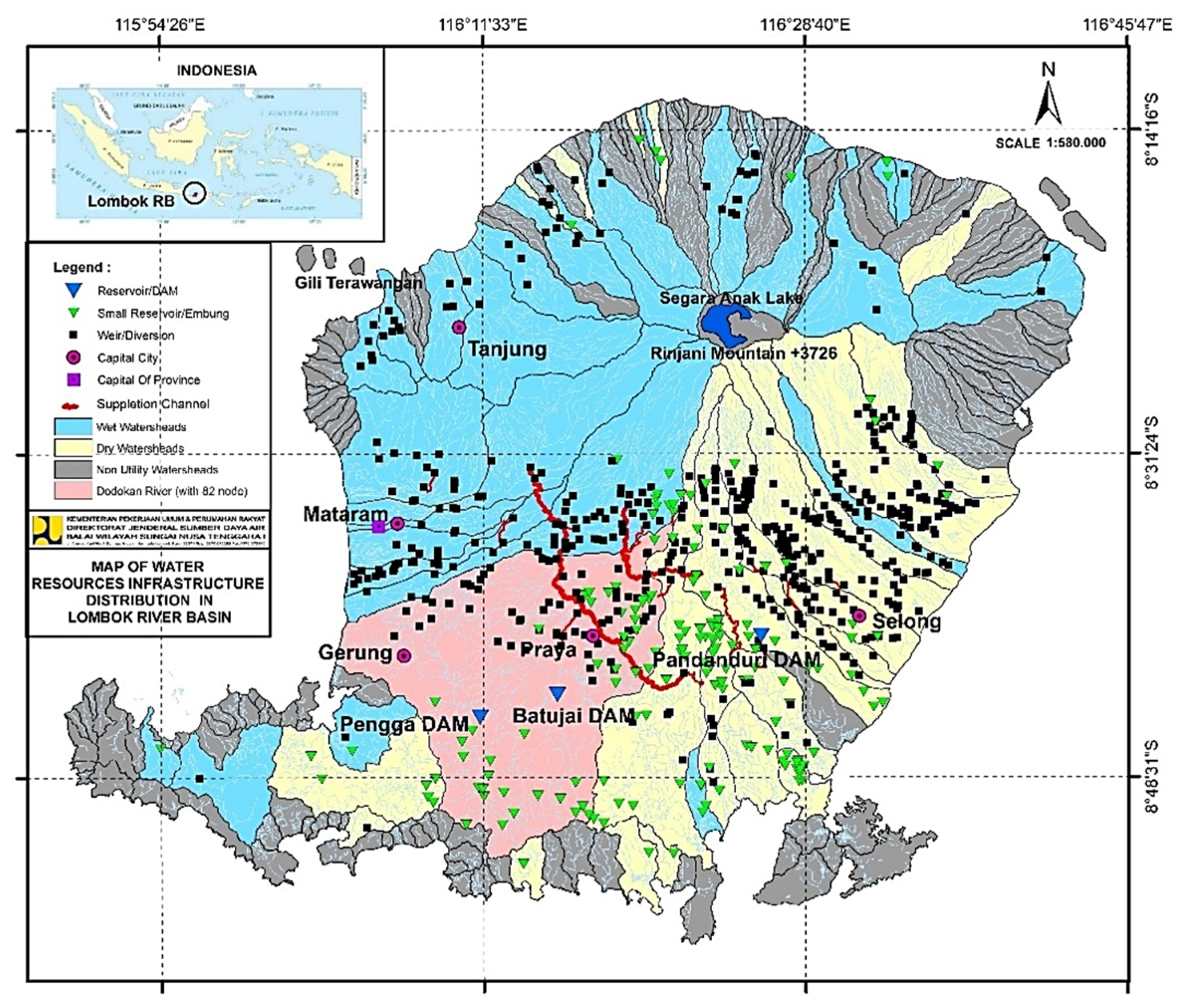
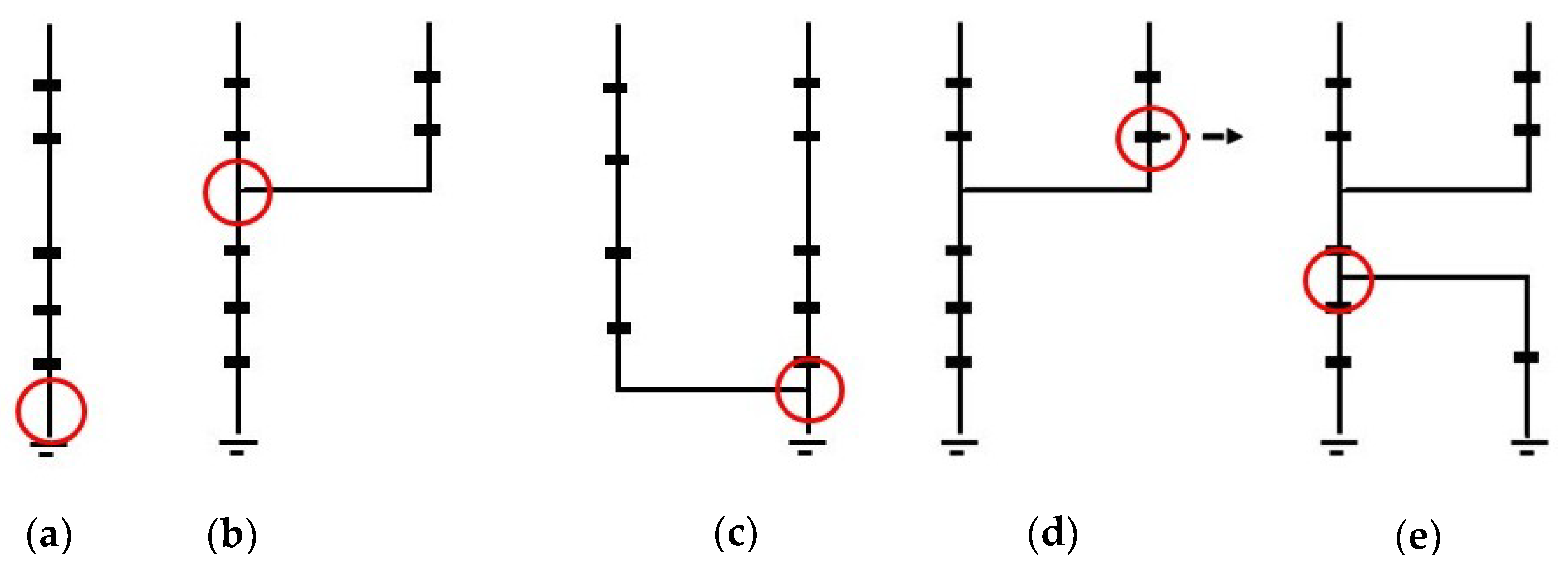
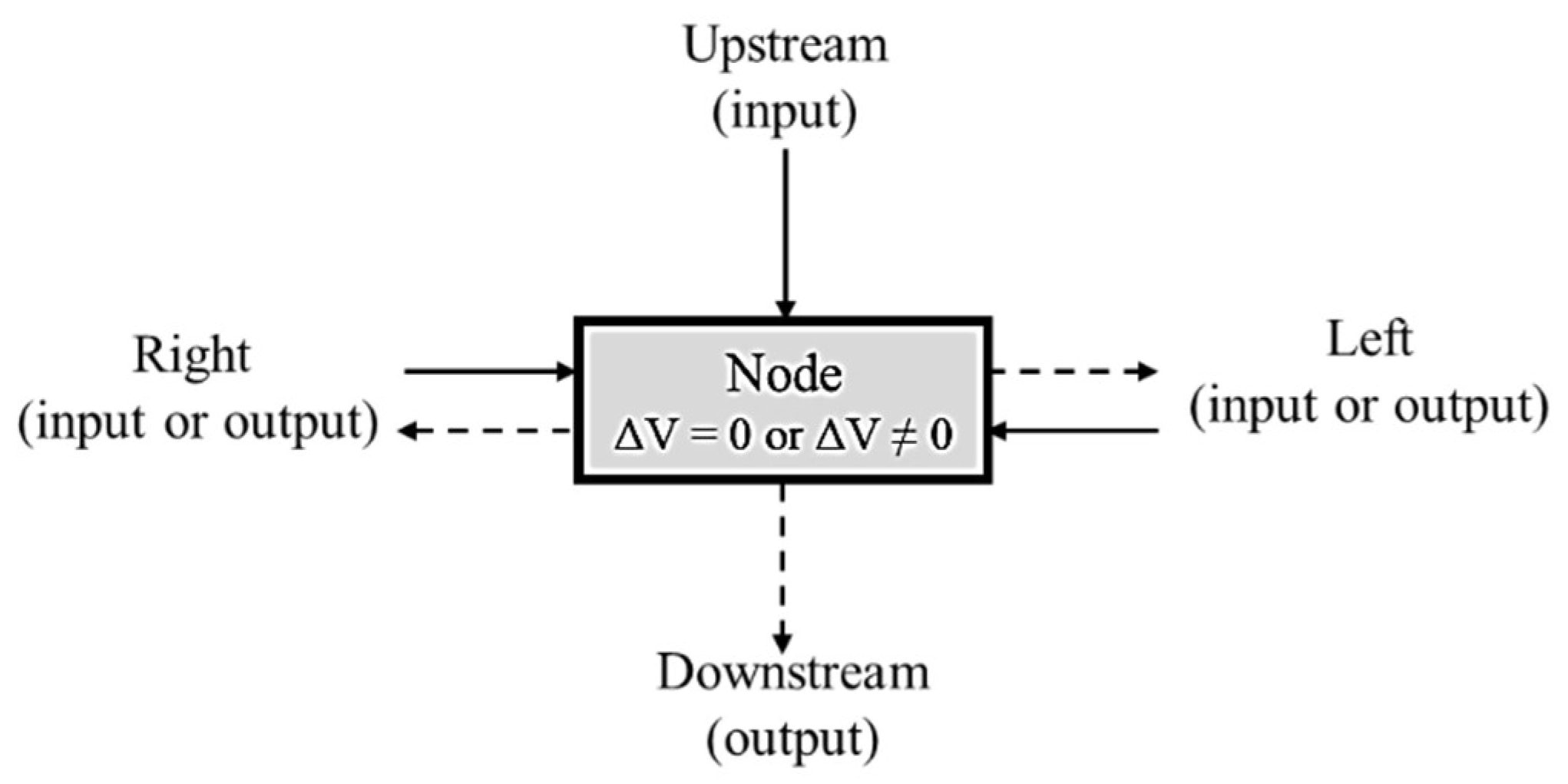
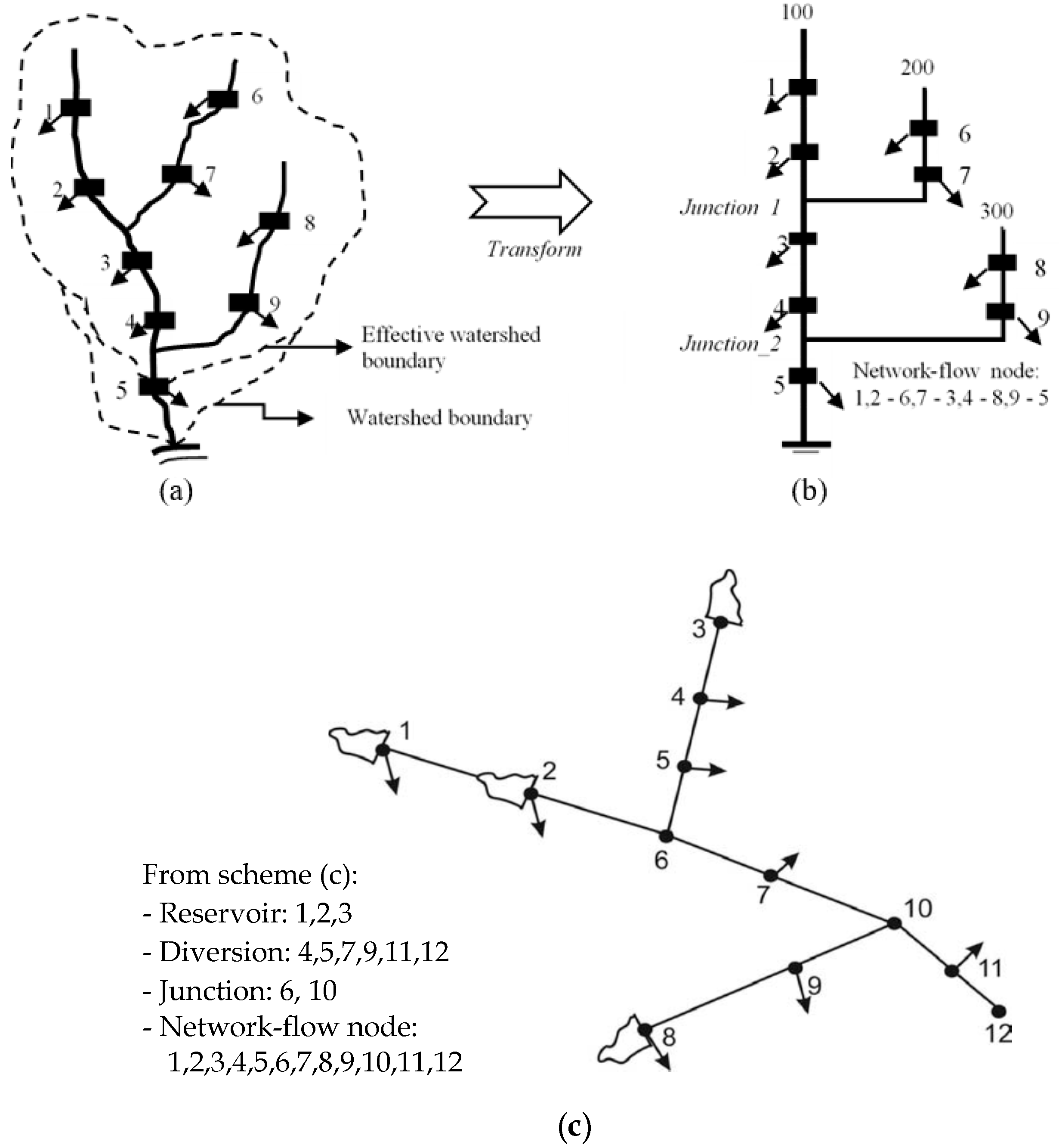
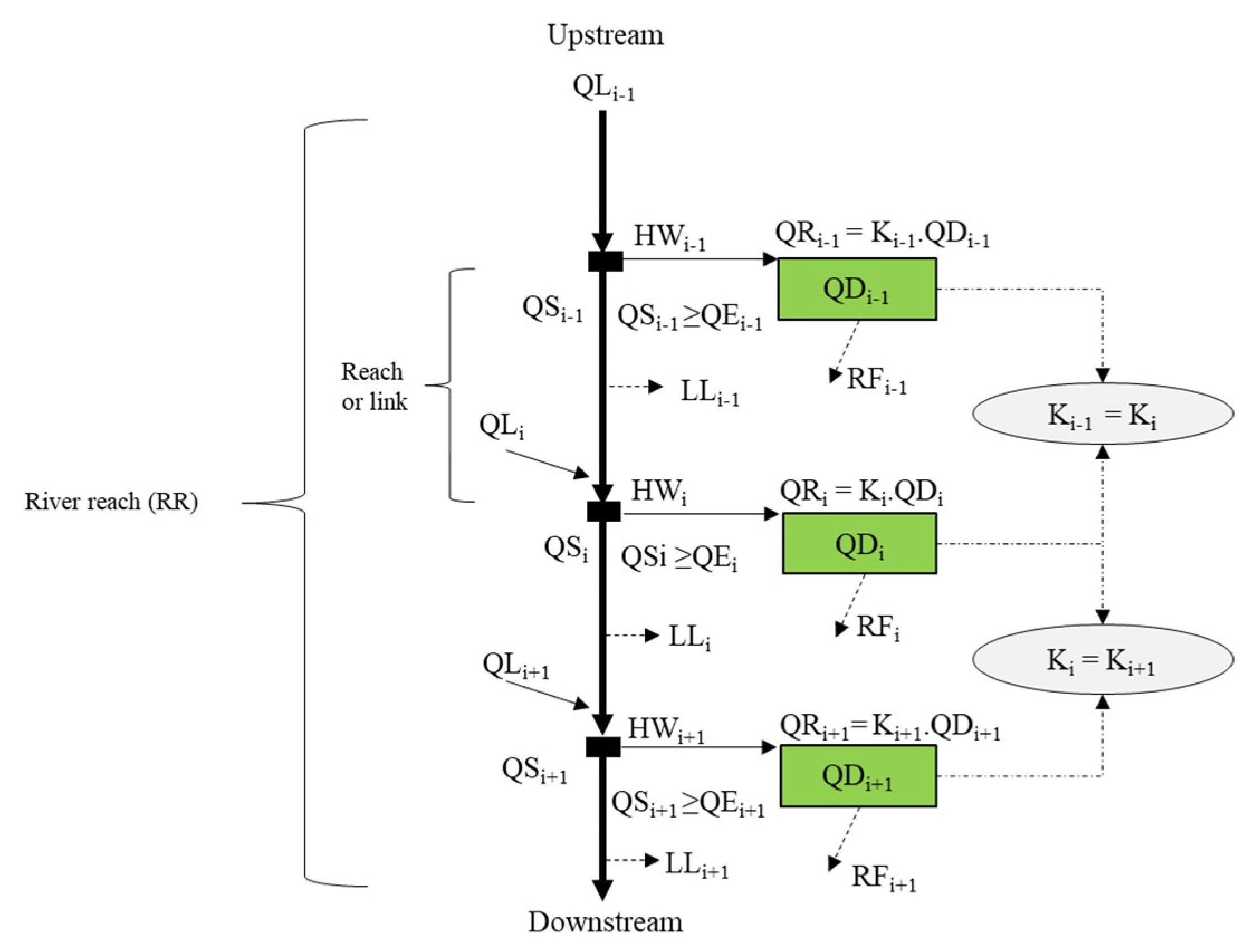
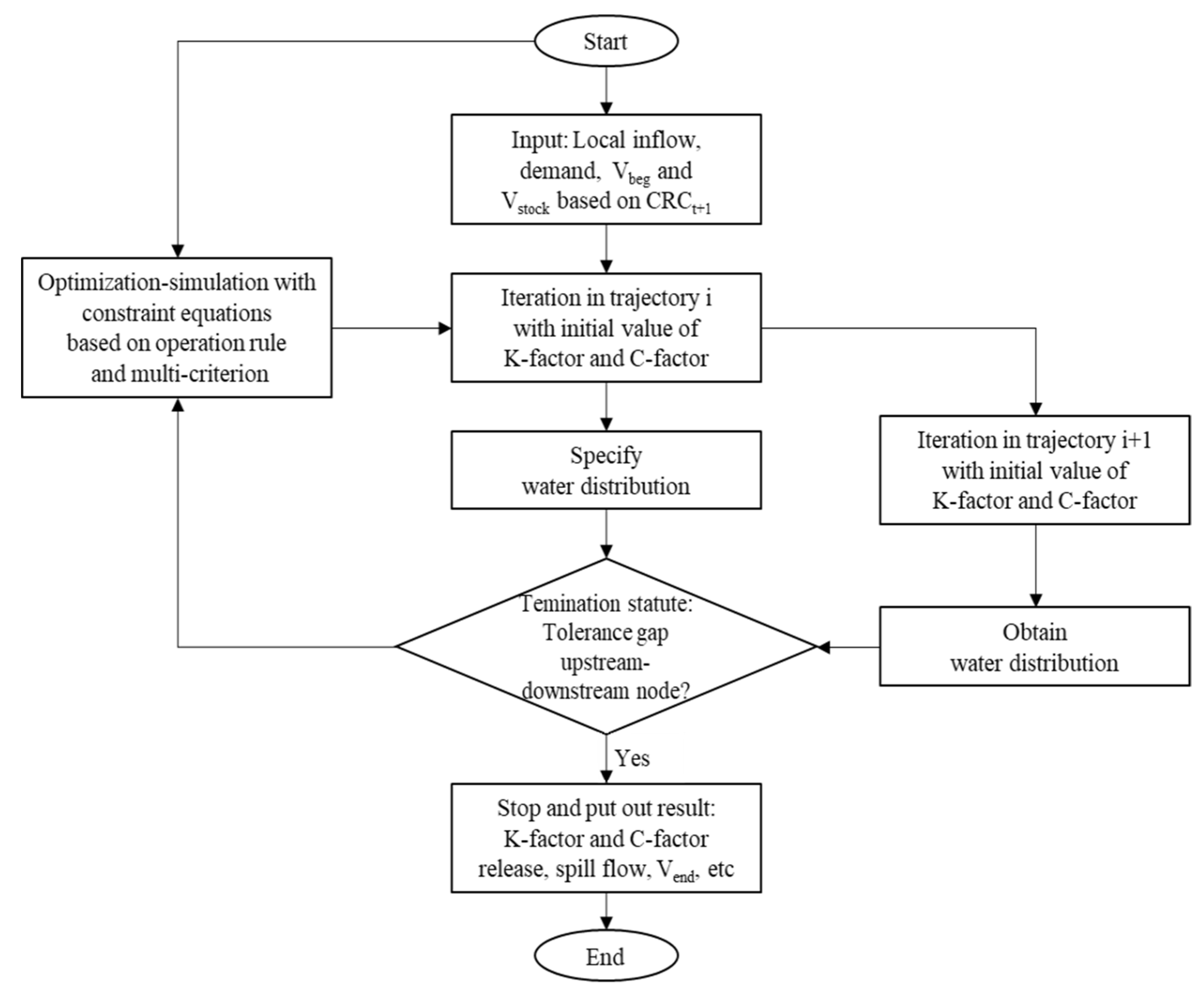
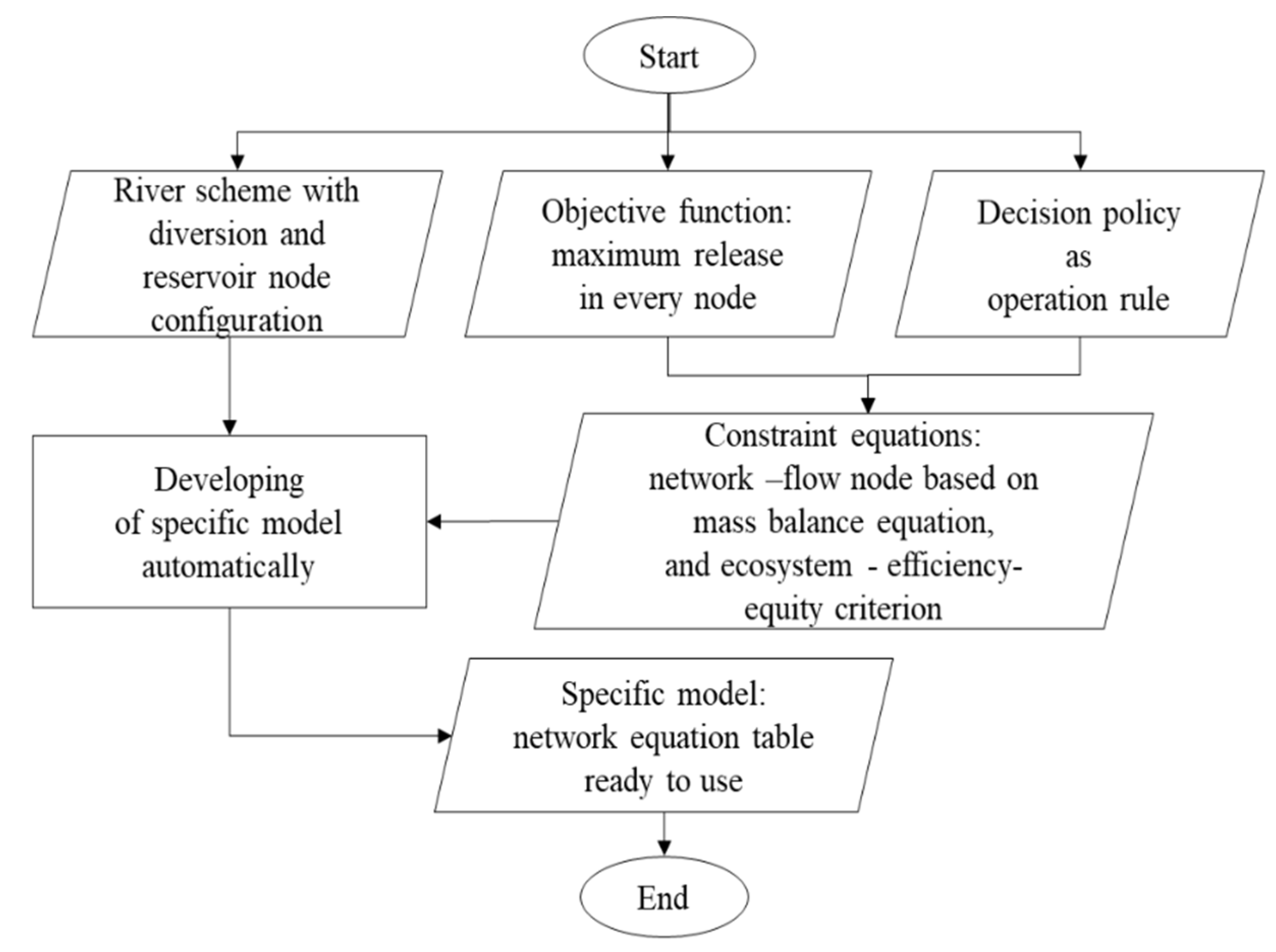
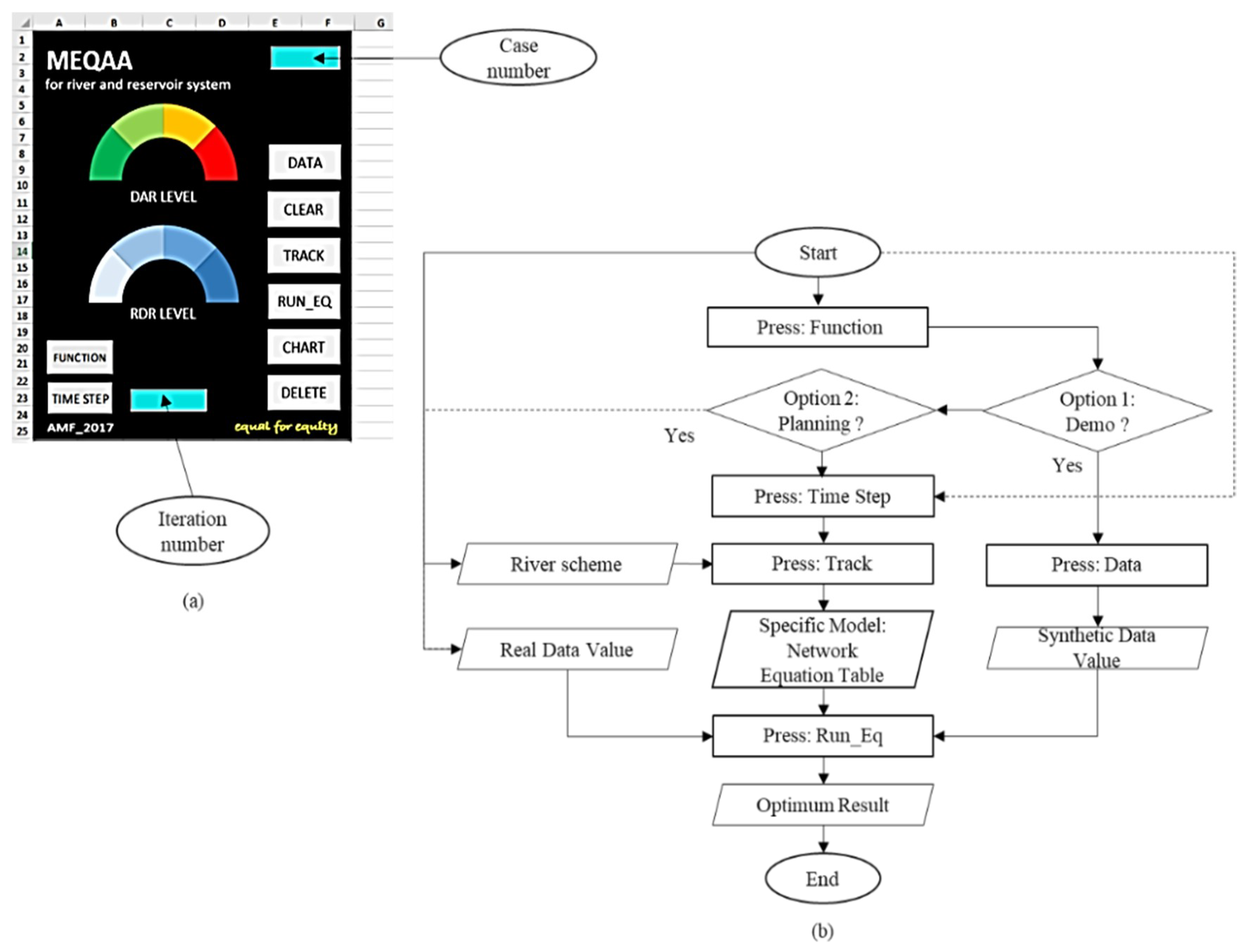
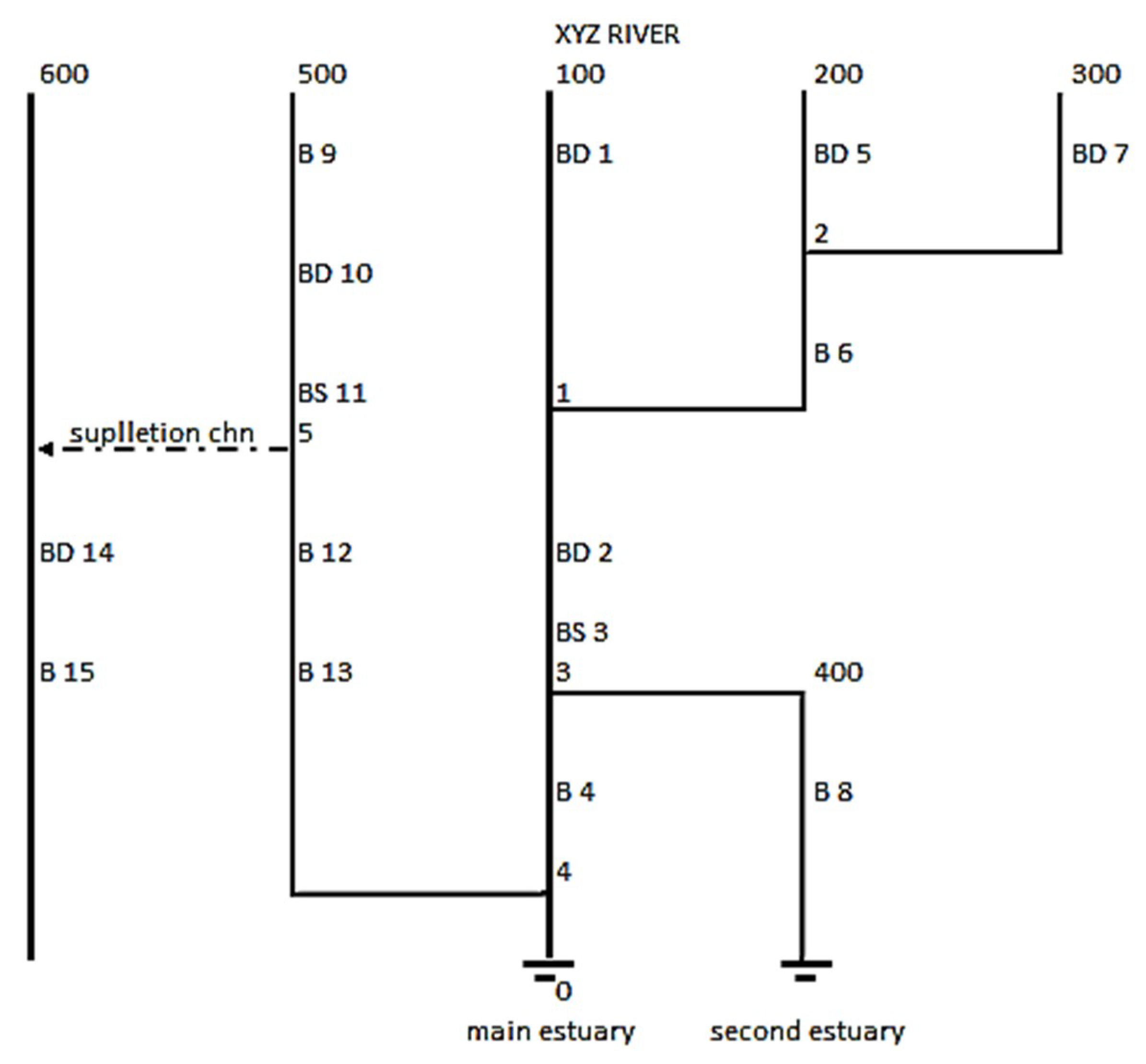

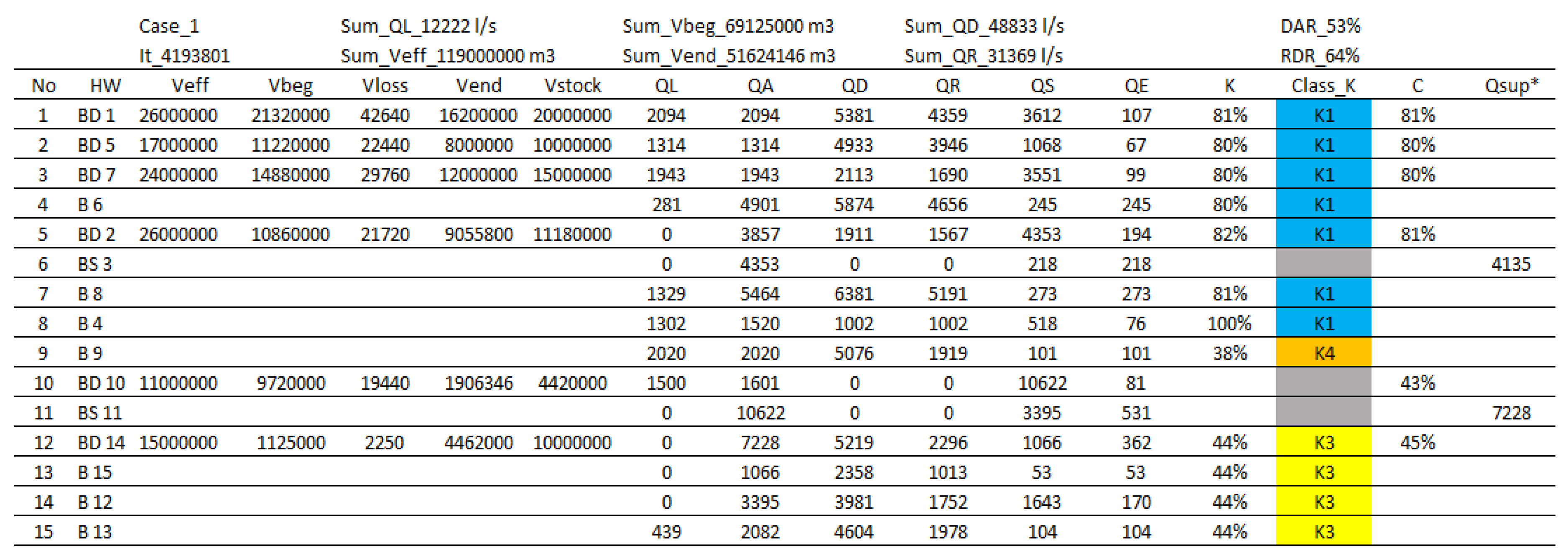
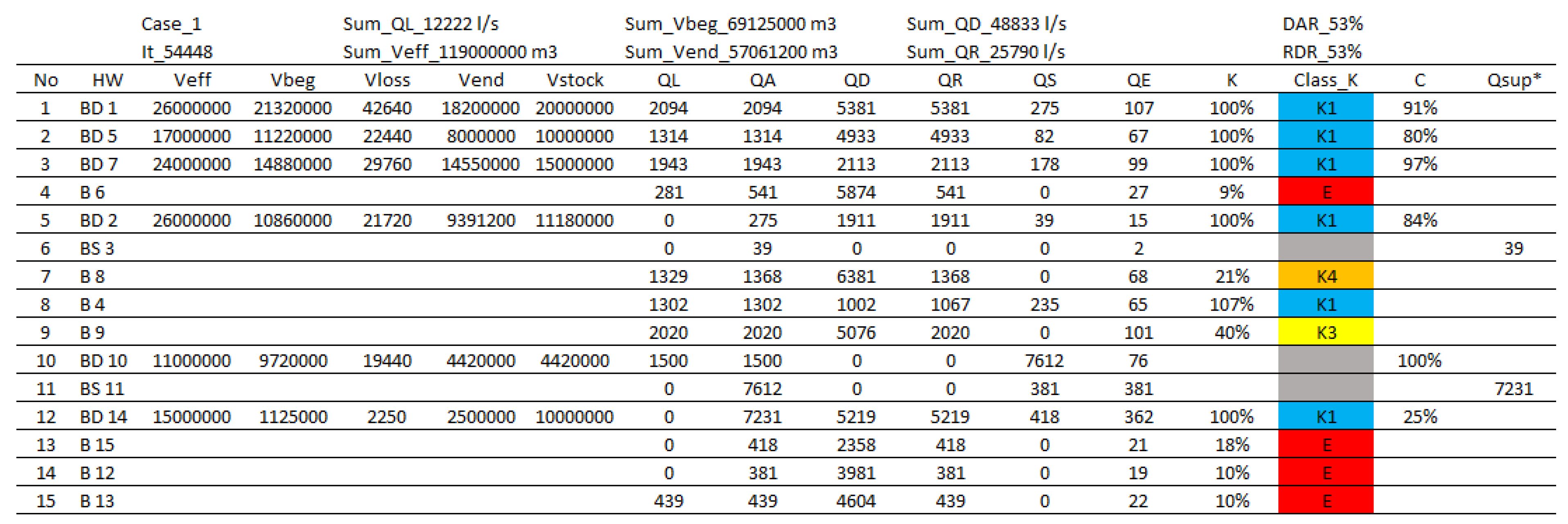
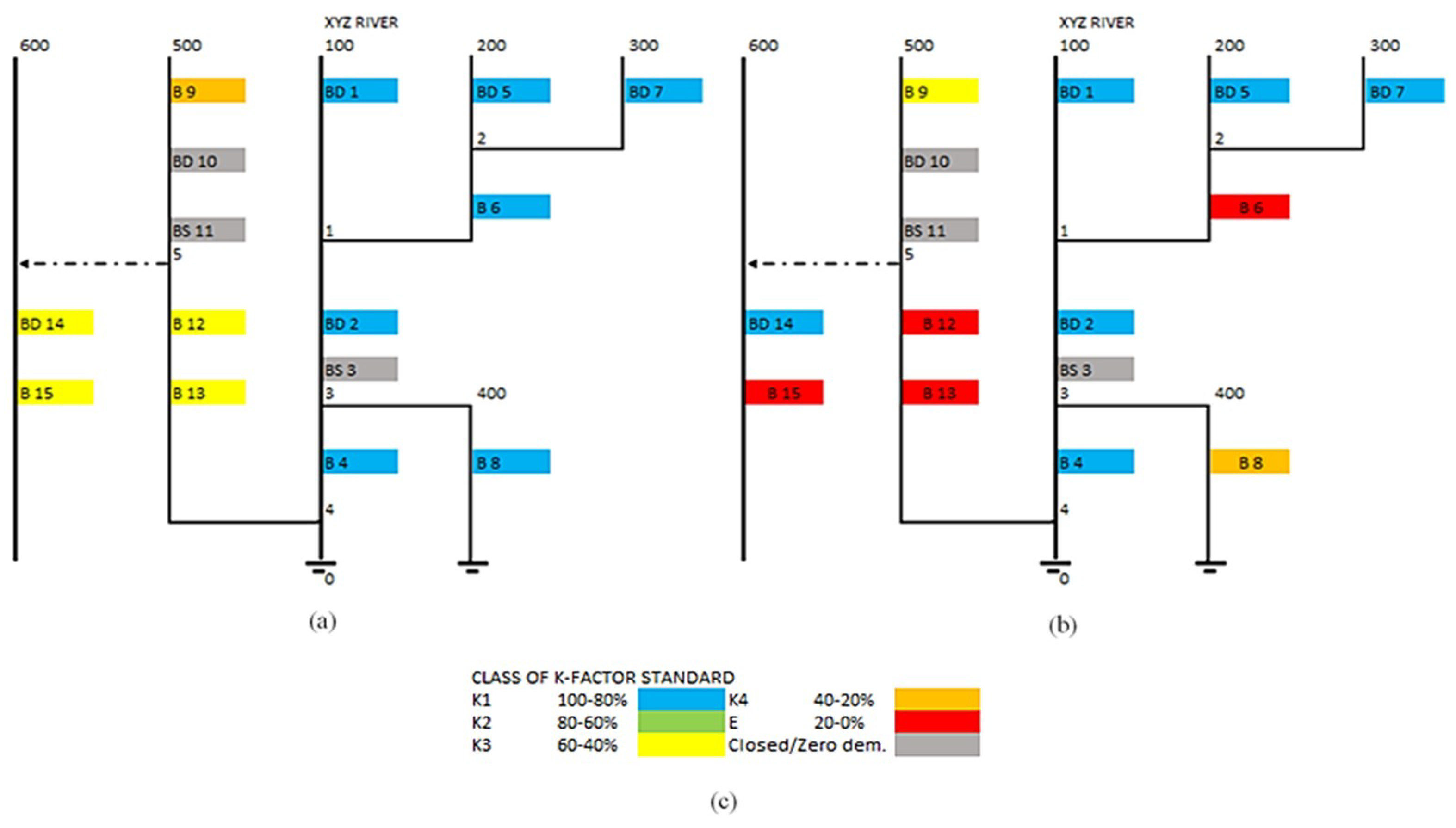
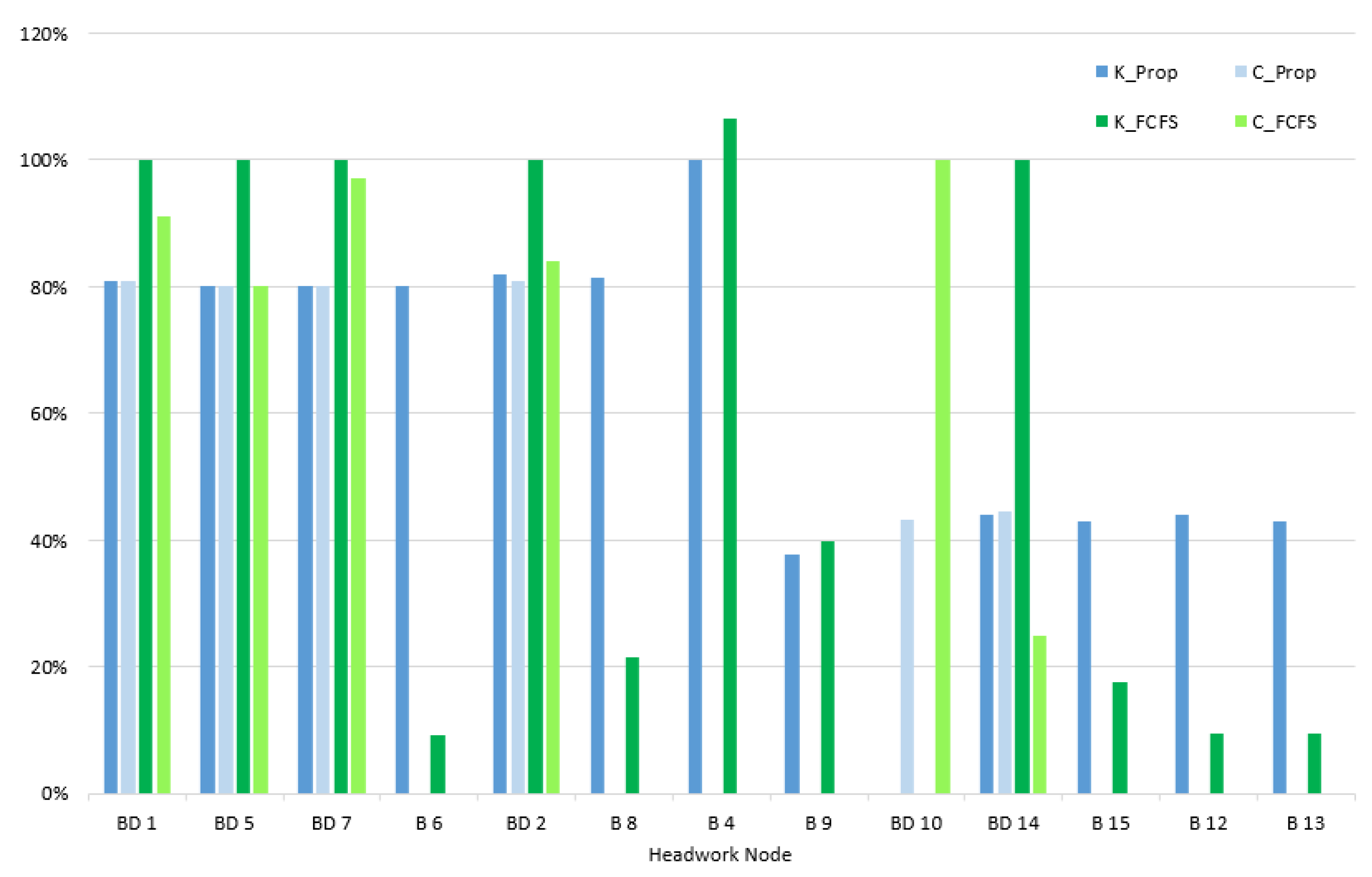
| Class | Range of K-Factor (%) | Deficit | Operation Categories | Interlude of Water Distribution |
|---|---|---|---|---|
| K1 | 80–100 | Zero-Very low | Continuous | - |
| K2 | 60–79 | Low | Rotation 1 | Short |
| K3 | 40–59 | Medium | Rotation 2 | Medium |
| K4 | 20–39 | High | Rotation 3 | Long |
| E | 0–20 | Very high | Emergency | Priority is inter-irrigation areas |
| Code | Usefulness | Description |
|---|---|---|
| 100 | Main river | Written above the main river |
| 200, 300, etc. | Tributary | Written above the tributary of the node |
| 1, 2, 3, etc. | River junction | Written on the junction, with formula {(tributary code − 100)/100} − 1 |
| 0 | Main river estuary | Written below the main river estuary |
| B | The initial name for diversion | Written in front of the node/object name |
| BD | The initial name for reservoir | Written in front of the node/object name |
| BS | The initial name for extern suppletion channel | Written in front of the node/object name |
| Item | Key Indicator | Releated Components | Function |
|---|---|---|---|
| K_draft | - | QR, QD | K iteration, from 100% to 0 with step ≤ 1% |
| Noneg | 1 | QA ≥ 0, QR ≥ 0, QS ≥ QE, QE ≥ 0 | Criteria indicator for decision variables without containing negative values. |
| Stor_key | 1 | DR_key include Vcal, QA, QD, QR, QE towards KC_key. | Criteria indicator for decision variables. |
| C_draft | - | Vend, Vstock, Veff | C iteration, from C_max to 0 with step ≤ 1%. |
| WB | 0 | Vbeg, Vloss, Vend, QA, QR, QS | Criteria indicator for water balance (input-output on mass balance equation) |
| C_max | - | Vcal, Vstock, Veff | Maximum value of C iteration. (0 ≤ C_max ≥ 100%) |
| CK_key | 1 | QS, QE, K, C, Vend, Veff | Criteria indicator for decision variables. |
| K_key | 1 | QR, QD, K | Criteria indicator for decision variables. |
| No | Notation | Acronym | Description | Equation |
|---|---|---|---|---|
| 1 | No | Node number | Output from tracking | - |
| 2 | HW | Headwork configuration | Output from tracking | - |
| 3 | Veff | Effective volume | Input data | - |
| 4 | Vbeg | Beginning volume | Input data | - |
| 5 | Vloss | Losses volume | Calculated | (9) |
| 6 | Vend | End volume | Calculated from Vcal (boundary operation) | (6) |
| 7 | Vstock | Stock volume anticipation for next operation period | Calculated | (8) |
| 8 | QL | Local inflow | Input data | - |
| 9 | QA | Water available (total inflow) | Calculated | (3) |
| 10 | QD | Water demand | Input data | - |
| 11 | QR | Intake release | Calculated | Connected |
| 12 | QS | Spill flow/contribution | Calculated | Connected |
| 13 | QE | Ecosystem water need | Calculated | (4) |
| 14 | K_draft, K | K iteration and optimum | Calculated | (5), (10), (12) |
| 15 | Class_K | Class of K | From Table 1 | - |
| 16 | C_draft, C | C iteration and optimum | Calculated | (7), (11), (12) |
| 17 | Stor_key, DR_key, CK_key, K_key | Termination status indicator at iteration process | Calculated | Connected |
| 18 | Noneg, WB | Control indicator at optimization criterion | Calculated | Connected |
© 2018 by the authors. Licensee MDPI, Basel, Switzerland. This article is an open access article distributed under the terms and conditions of the Creative Commons Attribution (CC BY) license (http://creativecommons.org/licenses/by/4.0/).
Share and Cite
Farriansyah, A.M.; Juwono, P.T.; Suhartanto, E.; Dermawan, V. Water Allocation Computation Model for River and Multi-Reservoir System with Sustainability-Efficiency-Equity Criteria. Water 2018, 10, 1537. https://doi.org/10.3390/w10111537
Farriansyah AM, Juwono PT, Suhartanto E, Dermawan V. Water Allocation Computation Model for River and Multi-Reservoir System with Sustainability-Efficiency-Equity Criteria. Water. 2018; 10(11):1537. https://doi.org/10.3390/w10111537
Chicago/Turabian StyleFarriansyah, Anang M., Pitojo Tri Juwono, Ery Suhartanto, and Very Dermawan. 2018. "Water Allocation Computation Model for River and Multi-Reservoir System with Sustainability-Efficiency-Equity Criteria" Water 10, no. 11: 1537. https://doi.org/10.3390/w10111537
APA StyleFarriansyah, A. M., Juwono, P. T., Suhartanto, E., & Dermawan, V. (2018). Water Allocation Computation Model for River and Multi-Reservoir System with Sustainability-Efficiency-Equity Criteria. Water, 10(11), 1537. https://doi.org/10.3390/w10111537





